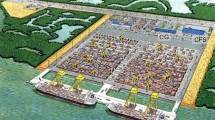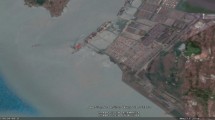Abstract
Cai Mep International Container Terminal was constructed 80 km southeast of Ho Chi Minh city, Vietnam, where a thick and soft clay deposit was widely found from the top of the ground. To minimize consolidation settlement after construction, soil improvement by PVD was extensively applied. Sand filling including preload up to +11.8 mCD was required on the existing ground of +3.5 mCD. Stability of this sand filling on river side was the first concern in the construction work. According to soil investigation to study shear strength profile of the soft clay, original design of sand filling was revised to maintain stability of the filling on river side. This report presents the original and the revised design, as well as the results of soil investigation.
You have full access to this open access chapter, Download conference paper PDF
Similar content being viewed by others
Keywords
1 Introduction
Cai Mep international container terminal was constructed as a part of Cai Mep-Thi Vai International Port Construction Project funded by Japanese ODA loan. The location is 80 km south-east of Ho Chi Min city, Vietnam, and very close to the river mouth of Thi Vai river. Quay structure for berthing, supported by pile foundation, is 600 m wide and equipped with 6 gantry cranes. Reclamation for terminal area behind the quay is approximately 38 ha. Construction of the terminal was started in Oct/2008 and completed in Oct/2012.
Due to wide distribution of a very soft clay deposit (more than 30 m thick) on the top of the ground in the reclamation area, application of prefabricated vertical drain (PVD) with preloading sand fill was planned to accelerate consolidation settlement. The height of the scheduled preloading fill exceeded 5 m because the expected settlement under preloading fill was more than a couple of meters. This height of preloading fill causes some concern about stability of the slope of the preloading fill on the river side.
Soil investigation was carried out in the early stage of construction to determine engineering properties of the soft clay deposit in not only the terminal area, but also under the river bed. Then, stability of the river side slope was evaluated. According to the stability analysis, a slope inclination milder than the original design was adopted together with a 30 m set-back of terminal area.
This report presents revision of the original design of reclamation work, including the results of soil investigation carried out in the early stage of the construction.
2 Location of the Site
Figure 1 presents the location of the site by a circle. It is 80 km from HO Chi Minh city and 20 km to Vung Tau city. The container terminal subjected to this report is shown by an arrow in the figure. As can be seen in the figure, the terminal is facing Thi Vai River, and it has the same kind of facilities on both sides. Since the location is very close to the river mouth, water level of the river is affected by the tide of the sea. HWL and LWL are +3.97 mCD and +0.58 mCD, respectively.
3 Original Design
Original design of berthing facilities is presented in Fig. 2. The width of the quay structure is 55 m and the top elevation is +5.0 mCD. Distance from face line of the quay to the retaining wall is 140 m, including 85 m long trestle.
The site is widely covered with soft clay deposit (SPT N values are mostly 0 to 2). Figure 3 shows the ground condition of the river bank. A low cliff is formed by a soft clay along river bank. This soft clay deposit continues to the depth of −38 mCD in the river and to the depth of −32.5 mCD in terminal area (24 m thick in river side and 36 m thick in land side), as indicated in Fig. 2.
Figure 4 demonstrates the shape of preload filling and counter weight mound in river side. Top of sand filling is +10.8 mCD at the river bank, and +11.5 m in terminal area. Soil improvement by prefabricated vertical drain (PVD) was extensively applied to accelerate consolidation settlement of the soft clay in the terminal area behind the retaining wall.
Due to wide distribution of soft and thick clay deposit, stability of sand mound presented in Fig. 4 was the first main concern to be considered. Since filling of counter weight mound was scheduled very early stage of construction, immediate study of stability was required.
4 Engineering Properties of the Soft Clay
Soil investigation was carried out to study engineering properties of the soft clay deposit and to evaluate stability of sand filling presented in Fig. 4. Boreholes were made on the river bed as presented in Fig. 5, as well as land side boreholes. Undisturbed sampling was performed with hydraulic piston sampler to take soil samples in high quality.
Figure 6 demonstrates water content, Atterberg limits and shear strength profile given by an on-land borehole. Natural water content is very close to or slightly higher than liquid limit, suggesting that the clay deposit has high compressibility. Direct shear test (DST) was performed with recompression method, in which test specimens (6 cm diameter and 2 cm height) were consolidated at in-situ overburden stress before shear. The factor of 0.85 (Hanzawa, 1992) was applied to consider the effect of deformation speed during shear on strength. The picture on right side of Fig. 5 shows advanced type DST apparatus used for the test. This apparatus can achieve constant volume condition (equivalent to undrained condition) during shear precisely.
The results of field vane test (FVT) in Fig. 6 are almost the same as DST results through the depth. The results of unconfined compression test (qu/2) are smaller than other two tests, except shallow part of the deposit.
Figure 7(a) presents undrained shear strength profile obtained by hand vane for riverbed boreholes (TCM01 and 02). Picture on the right side of Fig. 7 shows hand vane devise. This test was carried out for the soil sample in the sampling tube immediately after soil samples were retrieved from the ground. The factor of 0.85 was also applied as in the case of DST. As can be found in the figure, these strength values given by hand vane are slightly smaller than strength on land shown in Fig. 7(b).
Asada et al. (2005) studied the effect of release of overburden on shear strength of naturally deposited clay. They used DST apparatus shown in Fig. 6 and found that the effect can be expressed by Eq. (1), where Rsu is the ratio of su after swelling due to stress release to that before swelling, and OCR is the ratio of effective vertical stress before swelling to that after swelling.
The solid lines in Fig. 7(a) are derived by Eq. (1) from strength profile on land shown in Fig. 7(b). There is good agreement between the lines given by Eq. (1) and measured values. This strongly suggests that the river bank presented in Fig. 3 was formed by erosion, and riverbed soil was subjected to stress release.
For boreholes in the river, drilling machine was place on a platform supported by two small boats. Although the use of floating platform is efficient for drilling on the water, application of field vane test is difficult because of movement of platform due to tide and waves. This was the reason to use hand vane instead of field vane.
Figure 8 shows reliability of hand vane test. In the figure, hand vane results are compared with triaxial compression and extension test. Specimens for triaxial tests were first consolidated anisotropically, then sheared under undrained condition. As can be seen in the figure, hand vane results (factored by 0.85) are agree with the average strength of compression and extension triaxial tests.
5 Revised Design
According to the results of soil investigation, many cases of stability analysis were carried out, and cross section of preload fill and counter weight mound was revised as presented in Fig. 9. The slope inclination was reduced from 1:4 to 1:5, and the position of retaining wall was set-back 30 m. Figure 10 demonstrated quay and trestle of the revised design. There is no change in quay structure. The length of trestle was increased from 85 m to 115 m due to a 30 m set-back of retaining wall.
Concrete beam for trestle was also revised at the same time from prestressed concrete to reinforced concrete. Due to this revision, weight of concrete beams became much lighter than the original ones. This change made it possible to use smaller construction machine, of which preparation is much easier in the region than larger one.
6 Conclusions
Filling work in the project including counter weight mound and preload was successfully completed without any indication of sliding failure. Since soil data given by direct shear test and triaxial test presented in Figs. 6, 7 and 8 were not available at the time of design revision, shear strength profile of the soft clay applied to stability analysis was slightly smaller than that presented in the figures. This may give some contribution to successful completion of the filling work.
References
Hanzawa H (1992) A new approach to determine soil parameters free from regional variations in soil behavior and technical quality. Soils Found 32(1):71–84
Asada H., Tanaka Y., Suzuki K., Watabe Y.: Shear strength characteristics of marine clay subjected to swelling by direct shear test. In: 40th Annual Conference of Japanese Geotechnical Society, pp. 323–324 (2005). (in Japnese)
Author information
Authors and Affiliations
Corresponding author
Editor information
Editors and Affiliations
Rights and permissions
Open Access This chapter is licensed under the terms of the Creative Commons Attribution 4.0 International License (http://creativecommons.org/licenses/by/4.0/), which permits use, sharing, adaptation, distribution and reproduction in any medium or format, as long as you give appropriate credit to the original author(s) and the source, provide a link to the Creative Commons license and indicate if changes were made.
The images or other third party material in this chapter are included in the chapter's Creative Commons license, unless indicated otherwise in a credit line to the material. If material is not included in the chapter's Creative Commons license and your intended use is not permitted by statutory regulation or exceeds the permitted use, you will need to obtain permission directly from the copyright holder.
Copyright information
© 2023 The Author(s)
About this paper
Cite this paper
Suzuki, K., Sumita, Y. (2023). Construction of Cai Mep International Container Terminal. In: Li, Y., Hu, Y., Rigo, P., Lefler, F.E., Zhao, G. (eds) Proceedings of PIANC Smart Rivers 2022. PIANC 2022. Lecture Notes in Civil Engineering, vol 264. Springer, Singapore. https://doi.org/10.1007/978-981-19-6138-0_5
Download citation
DOI: https://doi.org/10.1007/978-981-19-6138-0_5
Published:
Publisher Name: Springer, Singapore
Print ISBN: 978-981-19-6137-3
Online ISBN: 978-981-19-6138-0
eBook Packages: EngineeringEngineering (R0)














